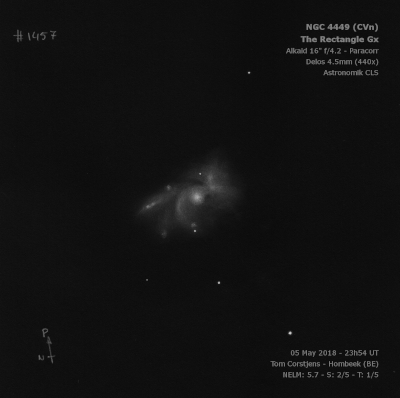
William Herschel discovered NGC 4449 = H I-213 = h1281 on 27 Apr 1788 (sweep 833) and recorded "very brilliant, cL, E from sp to nf, difficulty r, seems to have 3 or 4 B nuclei." His sketch at the end of 1811 PT paper (reproduced in Stenicke's book) clearly shows 4 condensations or HII knots within the glow, though one of these may be the nucleus. He used this an illustration of "Nebulae which are brighter in more the one Place." According to Wolfgang Steinicke, Caroline Herschel was next to find the object on 8 Jul 1793 in her 4.2-inch reflector, "and assumed it to be a comet!"
On sweep 150, John Herschel recorded "B; L; gbM; E in pos 75° nf to sp, a fine cluster; well resolved; I see several of the stars; 3' l, 2' br." On sweep 248 (last of 4 observations), JH wrote "vF; vL; vmE; it is either a double nebula or the nf end is bifid. If double the companion is F; R; bM; nearly north 1.5' or 2'. A fine object." So, clearly WH and JH resolved several HII regions in this galaxy. Lord Rosse or assistant Johnston Stoney noted on 17 Mar 1849, "3 nuclei or 2 nuclei and star, and faint neb outlying."
Based on photographs taken with the 60-inch reflector at Mt Wilson, Francis Pease (1917) described NGC 4449 as "..an irregular nebulous mass in which many nebulous stars [HII regions] are distributed unevenly. The greater part of the nebula is roughly rectangular, about 4.5'x2.5', p.a. = 40°, there being an assemblage of some dozen nebulous stars W of the SW corner. On the original negative there are 230 nebulous stars or patches...Two-thirds of them are in the N half. The nebulosity proper is weak toward the edge, gradually increases inward, and culminates along a central ridge, where it is as strong as the stars themselves. A number of dark irregular rifts appear here and there in it."
200/250mm - 8" bright, moderately large, elongated, bright core.
300/350mm - 13.1" (4/12/86): very bright, very large, elongated SW-NE, bright core, stellar nucleus. A knot is involved at the north end and the galaxy generally appears brighter to the north of the core. A star is superimposed close east of the core.
400/500mm - 18" (5/14/07): very mottled, irregular appearance, elongated ~2:1 SW-NE, ~5'x2.5'. The core is quite splotchy in appearance with a couple of bright knots; the most prominent is attached to the southwest of the core. The main body is roughly rectangular with an extension at the northwest "corner" that ends with a bright knot or knots ([HK83] #15). Another extension or knot ([HK83] #2) is off the northeast corner. A mag 13 star lies 2.4' E of the core and 1 or 2 additional very faint stars or knots are superimposed in the central region.
18" (5/8/04): fascinating view of this "Magellanic" system at 323x! The galaxy is very irregular in appearance and surface brightness with a large, bright, elongated core oriented SW-NE. The core appears offset to the south side of the galaxy.
Several knots (giant HII regions) are visible outside the core. The brightest is a well-defined obvious patch on the north edge of the galaxy, 1.5' from the center. This object is #15 in Hodge-Kennicutt's 1983 "Atlas of HII regions in 125 galaxies" ([HK83]) and it is nearly comparable in surface brightness to the core. Roughly 1' SE is #2, a smaller, faint knot that is collinear with #15 and a mag 13.5 star 2.4' E of the core. #25, a third difficult knot, can sometimes be glimpsed about 40" SW of #15. Finally, attached on the south end of the core is a larger, bright knot, although initially I thought this was just part of the core.
900/1200mm - 48" (2/20/12, 3/1/19, 5/1/19): NGC 4449 is a boxy-shaped Magellanic-type Irregular containing several bright, giant HII regions that are sites of active star formation. The galaxy has been intensively studied as one of the strongest galaxy-wide starbursts in the nearby universe. The overall surface brightness of the galaxy was unusually high at 375x. The very bright central region is elongated SW-NE, irregular in surface brightness and contains a small, intense "nucleus". This object is identified in SIMBAD as [GHG2001] 1 and described as a 10 Myr old super star cluster in the 2001 study by Gelatt et al, "The Star Clusters in the Irregular Galaxy NGC 4449".
To the southwest is a fairly large, bright patch that mimics a second core. This region is catalogued as #27/28/30 in Hodge-Kennicutt's 1983 "Atlas of HII regions in 125 galaxies" [HK83]. Several addition patches are on the north end of the galaxy. The largest and brightest is #15, a high surface brightness irregular glow at the north end of the galaxy, 20"x12", with a mottled surface and a stellar knot (#11) at the north tip. Roughly 35" SW is #25, a moderately bright roundish knot of ~12" diameter. 20" W is #31, a fairly faint, small HII knot, less than 10" in diameter. At the northeast tip of the galaxy is #2, nearly 1' SE of #15. It appeared as a moderately bright knot, ~15"-20" in size. A small knot (#16) was noted on the southeast side of the galaxy. A faint 12" knot is nearly detached at the SW end of galaxy (#6 in the 1969 "Kinematic study of ionized hydrogen in NGC 4449"). Very low surface brightness haze extends west off the SW end. A mag 14 star is superimposed [44" ENE of the nucleus].
On 5/1/19, I had the strong impression of an extremely low surface brightness glow nearly 10' SE of the galaxy (and 2.4' W of LEDA 2233323). This is the location of a tidal star stream, discovered in 2011.
Notes by Steve Gottlieb